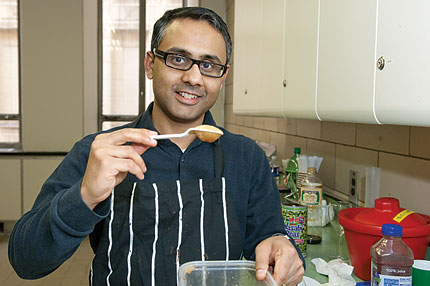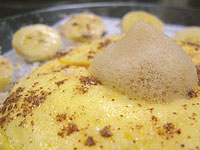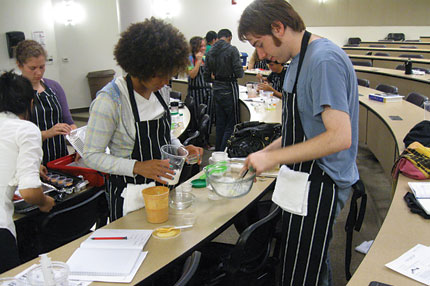
The Kitchen Chemistry Sessions

Award-winning chefs around the world are using chemistry to whip up deliciously strange dishes, including fruit juice caviars and peanut butter powders. In Assistant Chemistry Professor Subha Das’s “The Kitchen Chemistry Sessions,” students are creating their own culinary masterpieces—and learning a lot of chemistry along the way. During the seven-week mini course, students attend lectures in which they learn about chemical and biochemical concepts surrounding the major types of molecules found in food: water, fats and oils, carbohydrates, proteins, and flavor and aroma molecules. They then take these concepts to a kitchen laboratory to apply what they learned. “Using food as a context is a great way to teach chemistry. At the end of the course, I was amazed to see how much each student had learned and how they were able to apply the concepts,” Das said.
Recipes
 Banana Vauquelin
Banana Vauquelin
Ingredients:
- 1 egg white
- 1g imitation banana extract
- yellow food coloring
- 45g powdered sugar
- Combine one egg white and 1g imitation banana extract in a copper bowl. Whisk for a minute.
- Add two drops of yellow food coloring into the egg white mixture.
- Continue to whisk until soft peaks form and it appears a little glossy.
- Fold in powdered sugar.
- Empty the mixture into glass bowl. Microwave for 30 seconds. After briefly settling, the resulting foam should be moderately stable.
- Spoon foam onto plates and garnish with Nutella Powder, Honey Foam and banana slices.
The science behind the recipe:
Egg white is made up of water and several types of proteins. Whisking breaks the chemical bonds holding the proteins together, causing them to unfold and expose their hydrophobic and hydrophilic parts. Whisking also causes tiny air bubbles to form. At the point where air and water meet, the unraveled proteins orient themselves according to their hydrophobic (repelled by water) and hydrophilic (attracted to water) parts, creating multiple bonds with other unraveled proteins. The end result is a foam that holds the air bubbles in place.
Nutella Powder
Ingredients:
- 11 g Nutella Hazelnut Spread
- 8 g N-Zorbit M (tapioca maltodextrin)
- Measure Nutella into a bowl.
- Slowly add the tapioca maltodextrin, whisking as you add. When the mixture begins to resemble little pebbles of dough, decrease the amount of tapioca you add, stopping when you achieve a coarse yet slightly fine powder.
- Place a small amount in a mesh strainer and use a plastic spoon to push it through to achieve a consistent texture.
To make Peanut Butter Powder:
Repeat steps 1-3 with 11 g of peanut butter in place of Nutella.
The science behind the recipe:
Tapioca maltodextrin, a modified food starch, thickens and stabilizes fatty compounds. Inside your mouth, the powder reconstitutes into “real” Nutella or peanut butter.
Honey Foam
Ingredients:
- 38 g of blueberry blossom honey
- 60 g of water
- 0.5 g soy lecithin granules
- Combine the honey and water in a plastic bowl.
- Stir.
- Microwave 25 seconds on high.
- Add soy lecithin granules to the mixture and stir thoroughly.
- Using electric mixture, blend until a foam forms.
- When enough foam has been produced, spoon out as much as possible, and place it in a small plastic cup to preserve the integrity of the stable foam.
The science behind the recipe:
Soy lecithin is a naturally-occurring phospholipid, which has hydrophobic and hydrophilic ends. The water-loving ends of the lecithin wrap around the water molecules, which stabilizes the foam.
